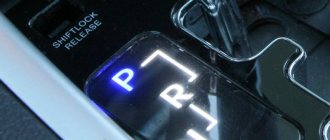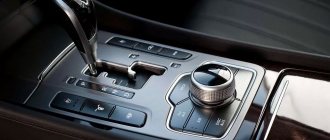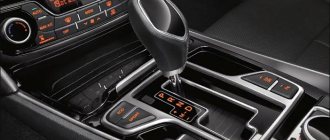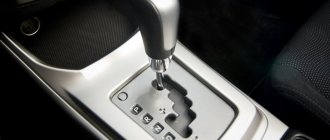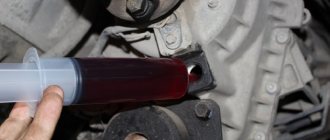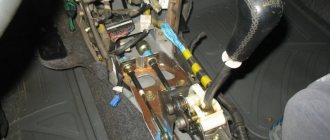Today I’ll tell you how to switch from manual to automatic. Although many car owners find it more difficult to drive a car with a manual transmission than with an automatic transmission. In most cases, problems arise among new car enthusiasts and girls who used manual transmission before switching to automatic transmission.
Write in the comments, have you had any experience of switching from a manual to an automatic? Or do you only drive your car automatically?
What is the difference between an automatic and a manual?
Everyone knows that to change gears on a manual transmission, a special device was invented - a clutch, which is necessary to break the mechanical connection between the gearbox and the car's engine. In an automatic, this unit is absent, and the driver has only two pedals under his feet.
The new switching method means completely different fuel consumption. In this situation, manual transmission benefits significantly, since the driver himself chooses the gear in which fuel consumption will be significantly less.
To control the switching, a special computer is installed in the automatic transmission, which does everything for the driver. Based on data about the speed of the vehicle, as well as engine speed, it sends the necessary impulse to the actuator, which changes the transmission stage.
Pros and cons of manual transmission
If we talk about the advantages of “mechanics”, then first of all it is worth noting the following:
- The efficiency is better than that of an automatic transmission. The “automatic” has a torque converter, which “eats” a significant part of the mechanical energy.
- Excellent acceleration dynamics. With the help of “mechanics”, the driver can accelerate the car much faster than if he drives with an “automatic”.
- Less oil consumption. A manual transmission needs about 3 liters; an automatic transmission may require about 10.
- Repair cost. Repairing a manual transmission is much easier and cheaper than repairing an automatic transmission.
However, compared to the “automatic” there are some disadvantages:
- Inconvenience. Of course, the main disadvantage is the need to constantly change gears and use your foot on the clutch. This is very difficult for novice drivers.
- If you use the “mechanics” incorrectly, there is a high risk of burning the clutch.
- Motor wear. If the engine constantly operates at high speeds, it may fail ahead of schedule.
As for fuel consumption, it is approximately the same for both options.
Control Features
So, you are still planning to become the happy owner of a comfortable car with an automatic transmission. In this case, it is necessary to study all the controls of such a machine. First of all, instead of a shift lever there is a special selector, which has several positions:
- N – Neutral gear, perhaps there are no differences from manual transmission here. This stage is intended for short parking with the engine running, as well as starting the engine.
- D – Drive. This mode is the most basic, since it is in it that all the necessary automatic switching up and down is carried out. Used more often than other modes.
- R – Everyone knows reverse speed. In this case, there is nothing to explain here.
- L – Low gear. To make it clearer, this is the same as first speed on a manual transmission. Necessary for overcoming difficult sections of roads, as well as during long ascents when the road is bad.
- P – Parking. This mode blocks the gearbox, as well as the drive that transmits torque to the wheels of the car. Necessary for long-term parking of a car to prevent any spontaneous movement.
In addition, there is a special button on the selector that engages upshift . It is necessary to save fuel during long and even driving on the highway. The essence of its action is to block the autotransformer (analogous to the clutch, only with oil filled), and also transmit torque most efficiently. Many drivers mistakenly confuse this mode with fifth gear, since when engaged there is a jerk and the speed drops. In fact, there can be no fifth gear here. To disable overdrive, simply press the button again or use kickdown.
Kickdown is a mode in which the engine will gain maximum speed before switching to the next stage. It is designed for quick acceleration, and also helps to easily and easily overtake any moving car. To switch to this mode, you must sharply press the gas pedal to the floor. A special automatic system will work, which will not allow gear shifting in normal mode.
Changing gears on automatic transmission
The gear shift occurs automatically; the driver only has to press the gas and brake pedals. To control the operation of the transmission, a lever is used. Having studied the basic modes, you can easily learn how to correctly change gears on an automatic transmission. Here's what driving theory says:
- P (from the English word parking) is intended for braking. At this time, the wheels are blocked while the engine is running. Use when parking or warming up the engine. You should not turn on the mode when driving or before every traffic light; it is better to use the brakes. Do not confuse the mode with the handbrake. The hand brake is more reliable.
- R (meaning reverse in English) is used to engage reverse.
- D (from the word drive - to go) is used when moving forward, and the gears are engaged automatically. Some machines are equipped with additional modes that are digitally designated. They are used when driving on different sections of the road (off-road, icy conditions, steep slopes, etc.). There is also a designation L or B for driving at a reduced speed (it is forbidden to turn on at a speed of less than 30 km/h).
- N (the English word neutral means neutral), in which case the car can roll freely if the brakes are not applied. It is used when towing or when moving a car with the engine turned off.
- O/D allows you to use higher speeds, which are usually in the off state. The button corresponds to 5 gears on the mechanics. It is not recommended to use it constantly.
Automatic gear shifting occurs when driving, when the gas pedal is depressed, and when mode D or R is turned on. Smooth release reduces the speed of the car.
How to use automatic transmission
Now is the time to learn how to drive an automatic car.
- To do this, you need to learn one simple rule - any change in the position of the selector must be made when the car is completely stopped and the brake pedal is depressed . Otherwise, you risk ruining the automatic transmission ahead of schedule.
- Always check the oil level before a long trip . The fact is that it not only performs lubricating functions, but also cools the entire assembly. When the engine starts, the oil pump is activated, which causes the fluid inside the box to circulate. Therefore, without it, you can not only overheat it, but also accelerate the wear of the gears.
- Before starting the engine, depress the brake and move the selector to the neutral position . After this, turn on the starter and let the box warm up for a while. Then turn on mode D and start moving smoothly, releasing the brake and then adding gas. When stopping, move the selector to the neutral position.
- The last thing I would like to pay attention to is towing . In case of any malfunction, it is advisable to call a tow truck. The fact is that when towing, the oil pump does not work and the transmission overheats, so the manufacturer recommends doing this over distances of no more than 30-40 kilometers with periodic stops to cool the unit. If you are the owner of an all-wheel drive car, then in this case you will definitely need to remove the driveshaft.
What you need to consider when switching from manual to automatic transmission
A car equipped with an automatic transmission has completely different control features, unlike a manual transmission. Drivers who have driven a manual transmission for a long time perform many actions automatically when driving - this is embedded in the subconscious.
If, after using a manual transmission for a long time, a car owner switches to an automatic transmission, his acquired reflexes can lead to serious consequences on the road. Before you get behind the wheel of such a car, you need to carefully study the possible risks.
Left leg . When driving a car with a manual transmission, the driver has full control over the operation of the engine and gearbox. Most maneuvers require frequent use of the clutch.
The first time is unusual for a driver who has switched from a manual to an automatic. After all, cars with automatic transmission have only 2 pedals - brake and gas. There are cases when the driver determines the discrepancy in engine speed by the nature of the sound, and at this moment the reflex is triggered. The foot tries to find the clutch pedal. Since cars with automatic transmission do not have it, the driver can accidentally touch the brake pedal - this leads to a sudden stop. In fast driving conditions, such a mistake can cost the driver his life.
In manual cars, the gas and brake have a small stroke, so you don’t need to press hard on them. And the clutch pedal has a long run-up, so drivers reflexively press it with great force. This habit can lead to a traffic accident when driving a car with an automatic transmission.
To avoid this, you need to focus on movement. It will take some time to get used to the new controls. At first, it is not recommended to drive at high speed.
Other errors that lead to transmission failure . Driving a car with automatic transmission is very easy. You just need to form habits and become familiar with the most common mistakes in order to avoid them in the future.
To increase the service life of the box, you must avoid the following mistakes:
- You cannot switch the selector until the car stops. This can greatly overload the transmission.
- You cannot switch modes until it stops completely. First you need to brake the car with the pedal, and only then select a mode.
- Many drivers go down hills in neutral to save fuel. However, this function is already handled by the injection control system. In addition, such driving can seriously damage the box.
- An automatic transmission requires constant care. The oil in it needs to be changed every 60,000 km - its service life depends on this.
- You cannot set the “parking” mode until the car has stopped completely. An error can lead to serious consequences that will require expensive repairs.
- You cannot start the engine in neutral. It is better to set the mode to “parking”, and then move it to position “D”.
- Often an automatic transmission icon appears on the dashboard - this indicates overheating. In such a case, you need to stop and wait a while until the car cools down.
Bottom line . Switching from a manual transmission to an automatic transmission always requires training and some skills. It is important to form some habits in the subconscious, and then driving will be a pleasure.
Automatic engine braking
For an inexperienced driver, operating an automatic transmission after a manual transmission can lead to some errors. It would be correct to fully press the brakes and turn on mode D before stopping the vehicle. When stopping for a long time, set the mode from P to N and you can remove your foot from the pedals after braking.
The hand brake is used in situations where it is required:
- stopping with the engine running or on a slope;
- stopping to change wheels.
Don't ignore using the handbrake while driving an automatic.

